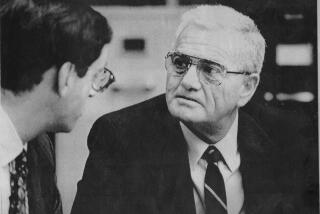A hijacker’s bullet set Jackie Nink Pflug on a long, hard road
- Share via
Jackie Nink Pflug was shot in the head at point-blank range, rolled down a set of metal stairs and left for dead on an airport tarmac in Malta in November 1985. The man wielding the gun was one of five Palestinian militants who had hijacked EgyptAir Flight 648 bound from Athens to Cairo, where Pflug was a psychologist and special education teacher at a school for international students.
By training and by nature, Pflug had always been a problem solver, quick to come up with a solution to a child’s reading problem or a classroom dilemma. As she passed in and out of consciousness on the tarmac, she was acutely aware that a hijacker had just pumped a bullet into her brain, that she was lying in front of an airplane wheel and that the airplane’s engines continued to whine. She knew she was supposed to be dead but also knew she was not. For five hours, she readied herself to roll out of the wheel’s way but willed herself to lie perfectly still, lest the hijackers discover their mistake and finish her off.
In weighing the prospects for survivors of grievous head wounds, researchers say there is no better predictor of rehabilitative progress than a survivor’s ingoing intellect, education, problem-solving skills and mental discipline. That fact clearly bodes well for the rehabilitation of Rep. Gabrielle Giffords, a Fulbright Scholar with a master’s degree in regional planning. For Pflug, mental strength has been a key to recovery.
The .38-caliber bullet had shattered her skull in an area the span of her hand. Where it entered her brain, above and behind her right ear, her head was caved in completely. The bullet lodged deep in her brain after passing through structures that process sensory information and contribute to memory and spatial perception. The violence of its entry had set off shock waves across her whole brain, causing massive swelling throughout.
When she awoke in a hospital ward in Malta, she knew that her eyesight was strangely constricted. But she could see well enough to know that her would-be executioner was in the next bed over. Her brain’s fear mechanisms were in overdrive.
The words that had always flowed so easily failed to come to her. Only after another passenger identified the surviving hijacker was he moved.
Nor could she process the words coming into her brain. Told to brush her teeth, she needed to have the words repeated, the toothbrush displayed and a demonstration of how it was used.
Married just five months, Pflug returned with her then-husband to Minnesota and began an agonizing recovery. With no rehabilitation help forthcoming, she inventoried her own impairments as she discovered them and set about addressing them one by one. “I didn’t wait around to find out what was going to come back on its own.”
She needed to learn to tell time again, to recognize and count money, to hold more than a single thing in her memory at a time.
Pressing a red pen to the page of a newspaper and only lifting it when she saw a period, she taught herself to make her eyes move from left to right across a page and to digest the meaning of one word, one phrase, one sentence, before moving on to the next.
With all her peripheral vision gone, she learned to navigate uneven surfaces and unfamiliar places by scanning her surroundings with the small central field that remained, and waving her hands to protect her flanks from unseen objects.
For years, she contended with searing headaches, painful sensitivity to sound, epileptic seizures, terrifying nightmares and waking fears that made her want to shut herself off from the world. Her fears that the terrorists would hunt her down and kill her were irrational, she told herself, and she marched herself to a therapist three times a week until she could exorcise her demons. “I am a believer in getting help,” she says.
Within two years, her skull was repaired with a metal plate, and within three years she was driving. Within five, her sensitivity to sounds began to subside, and she had worked her way from a kindergarten reading level to the 12th grade. With medication, her seizures were under control.
Her vision remains limited to a narrow spot at the center of her field. Today, she can see her teenage son, born 13 years after her brush with death, only by scanning him up and down and side to side, and creating a full picture in her mind.
Pflug knew that a return to teaching was out of the question. But she also knew that she had lessons to teach about coping with adversity. She could write and, using tape recorders, notebooks and sticky notes, she had stretched her ability to hold things in memory. She enrolled in a public speaking course, wrote her story (her 2001 book, “Miles to Go Before I Sleep,” details her ordeal and long road back) and hit the speaking circuit.
She counts her blessings nightly and believes every experience holds a lesson.
In the journey of life, she says, “at some point or another along the way, we all get hijacked.” The trick, she adds, is “taking the most difficult choices and becoming the most capable person that you are.”







